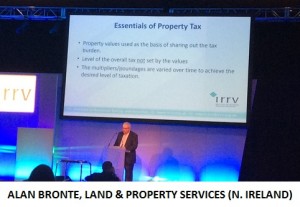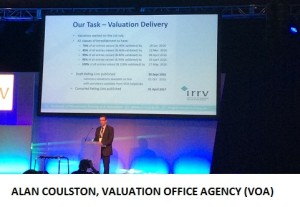Following the government’s announcement on Local Authorities being able to retain 100% of Business Rates, Council’s have even more of a vested interest in the outcome of the revaluation currently taking place.
 We heard from Alan Bronte, Commissioner of Valuation for Northern Ireland, Land and Property Services, who provided some key insights on the purpose of the business rates revaluation having been through the process recently himself in Northern Ireland. Alan pointed out that to be a good and fair tax, key processes needed to be in place particularly in areas such as assessment, billings and appeals.
We heard from Alan Bronte, Commissioner of Valuation for Northern Ireland, Land and Property Services, who provided some key insights on the purpose of the business rates revaluation having been through the process recently himself in Northern Ireland. Alan pointed out that to be a good and fair tax, key processes needed to be in place particularly in areas such as assessment, billings and appeals.
The revaluation helps redistribute the liability according to differential movements in value and uses modern values to restore a fairer relationship between rent and tax. To achieve a fair revaluation, Alan noted that the underlying data behind it needed to be good with market evidence gathered to support decisions and appropriate analysis and adjustment made, alongside having people on board with the right knowledge.
Revaluation timescales

Alan Coulston, Director of National Specialists Unit, Valuation Office Agency (VOA) noted that the VOA were currently around 20-25% of the way through the current revaluation in England and Wales (as at start of October 2015) and that they were back on track for delivering an update every five years.
Alan provided details of a timetable the VOA were working to as outlined in the table below.
| All classes of hereditament to have: | Date |
| 70% of all entries valued (& 40% validated) by | 29 Jan 2016 |
| 85% of all entries valued (& 60% validated) by | 13 Mar 2016 |
| 90% of all entries valued (& 80% validated) by | 08 Apr 2016 |
| 95% of all entries valued (& 90% validated) by | 29 Apr 2016 |
| 100% of all entries valued (& 100% validated) by | 27 May 2016 |
| Draft Rating Lists published | 30 Sep 2016 |
| Summary valuations online | 01 Oct 2016 |
| Compiled Rating Lists published | 01 April 2017 |
Alan noted that once the draft Rating List was published some maintenance and input work would be required from Local Authorities and Appeals. He also commented that where rates needed to be set if there was no defined rental income such as schools, universities and hospitals a decapitalisation rate would be set by government.
The Revaluation process
Alan went into some of the detail of how the VOA are assembling evidence on which to set rates, this included using stamp duty and land tax forms from the last seven years as well as engaging with representatives from a number of different sectors, issuing forms for trade and throughput information to be completed.
Around 1,800 market knowledge reports have also been compiled internally by the VOA to track the market at various points in time and covering percentage movement on values. Following this analysis practice notes have been produced setting out a required approach specific to the list year and discussions entered into across a variety of industries on these.
In some cases prior agreement schemes have been reached, for example within bingo halls, cinema’s, health clubs, holiday centres, football stadiums, stately homes and pubs.
Revaluation findings
Alan also noted some revaluation findings and issues such as the retail market still being weak in many locations, although the convenience store market remains buoyant. There has been a growth in the service industry in London with more hereditaments added to the list and the automotive sector appeared to be doing well. The consolidation of post offices going to convenience stores has had some implications and new classes have been added to the list including click and collect, kiosks and car washes.
Reducing unnecessary Appeals
A key part of the revaluation programme is to try and support a reduction in unnecessary appeals and the VOA believe this can be achieved through better communication and awareness. This will mean working with Billing Authorities and sending a letter out to all ratepayers notifying them of the availability of summary valuations being online. Once this has been completed, next steps will include handling ratepayer enquiries prior to publication of the final list. When this exercise was conducted last time around, Alan noted that there were over 100,000 enquiries and it enabled the VOA to deal with many errors and mistakes prior to launch.
Alan concluded by saying that the revaluation is all being conducted under scrutiny, with a lot of checking and challenging occurring and a focus on exemptions and liability criteria to ensure findings are fair.
Key Insights from Northern Irelands Revaluation
Following Northern Irelands recent Rates Revaluation Alan Bronte shared some key insights from their experience noting that at the time, ratepayers had high expectations of everyone being a winner. Communications and engagement was a key part of the process with everything explained clearly at the start of the process. Letters were sent to all known ratepayers with passwords for them to complete their rental details online. Over 83% of the calls which were taken during this period were handled there and then with no need for follow up.
Between 2001 and 2013 there was a notable 8% overall growth. In Belfast City Centre some prime areas had a 50% decrease in rateable value whereas large food stores and retail parks increased in rateable values. Hotels saw above average rises in rates, power stations decreased, wind farms and gas increased and telecoms declined.
In summary, Alan notes that 6 months on, only 3% of the Northern Ireland list was challenged, it is widely believed to have rebalanced the rating system and is attributed as a major factor in the resurgence of demand in Belfast City Centre.
